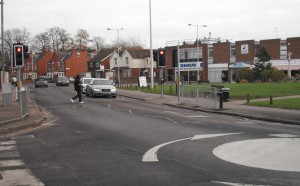Traffic managers at the council have come up with new plans to improve road safety along School Road in Tilehurst, in part due to a number of incidents involving pedestrians in recent years. The plans call for:
1. A number of traffic islands along School Road to make it safer for pedestrians to cross.
2. Removal of the bus lay-by in The Triangle.
3. Creation of a new bus lay-by in Corwen Road.
4. A new 20 mph limit along School Road, Walnut Way and the closes off them.
5. A safety barrier (guard railing) in front of the library.
The lay-by in The Triangle is used by the 33 buses as a timing point so buses may be parked there for several minutes. Moving the lay-by to Corwen Road will allow pedestrians to cross using a new island in front of Barclays Bank without the buses holding up traffic. The 17 will continue to use the bus stop which will move slightly closer to the traffic lights, but on the road and it does not use this stop as a timing point. The lay-by outside the Plough will not be changed.
Pedestrians can use the new islands to cross over School Road and also to avoid the tricky crossing of Westwood Road where mums, schoolchildren and elderly folk currently have to walk in between cars.
All in all the plans are welcome although we would have preferred a much wider 20 mph zone incorporating a lot more of Tilehurst’s residential roads.
You can see the plans here on the main Reading Lib Dems website.
Feel free to send any comments in to the ouncil, in fact the more comments you send in the better. And do not forget to mention the need for a safety barrier outside the library to stop very young children from running out into the street.




